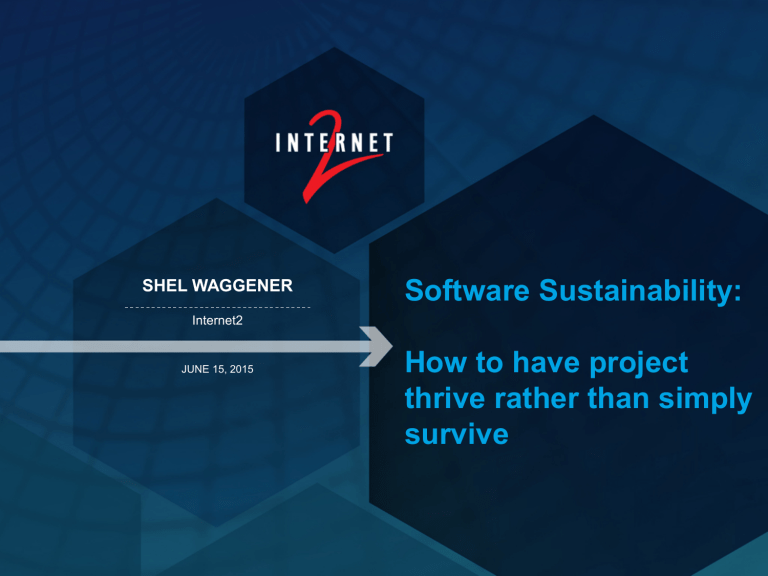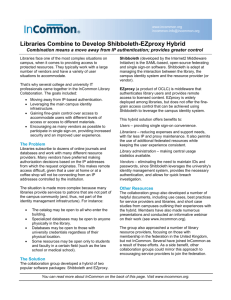About Internet2

SHEL WAGGENER
Internet2
JUNE 15, 2015
Software Sustainability:
How to have project thrive rather than simply survive
We all have a lot of good ideas …
And we deliver on many of them.
THEN WHAT?
MONEY FROM HEAVEN (?)
The majority of Internet2 Software
(Middleware and Applications) are funded by one time grants (federal or community funds) to do initial development and prove the concept.
First Challenge:
Do you know what Success Looks Like?
How often do you have project that has a clear landing
WHAT ACTUALLY HAPPENS
Everyone involved in the project (and those who aren’t but use the software define success locally (and differently).
Second Challenge:
Regardless of local success definitions, the project itself is quickly out of original resources and doesn’t have the resources to continue.
This is either project originator
OR those users that need it to be sustained and supported.
SO WHAT OPTIONS EXIST?
FOUR POSSIBLE PATHS
1.
Community Contribution: A named list of community individuals or entities agrees to
“keep the project going”.
Traditional: Passion works well but very difficult to scale over time.
Example: Filesender
SO WHAT OPTIONS EXIST?
FOUR POSSIBLE PATHS
2.
Rolling to Next Grant: a favorite of higher education and NREN’s, look for grants for innovation of the base technology and inject new capital every few years.
Traditional: Eventually innovation is replaced by simple sustainability which isn’t exciting to grant funders.
Example: Grouper, CoManage
SO WHAT OPTIONS EXIST?
FOUR POSSIBLE PATHS
3.
Taxation: Hide the funding within a larger pool of funding where the service is required
Traditional: Particularly for middlware, create required or expected “tax” to create sustaining funding pool for maintenance
Example: Shibboleth Consortium (mix of contribution, subscription and taxation)
SO WHAT OPTIONS EXIST?
FOUR POSSIBLE PATHS
4.
Subscription: By usage, monthly or annual contribution (fxed or by usage) for access to the software.
Traditional: Easier in the world of cloud but faces most common challenge of subscriber budget models that are based on one time funding
Example: TIER
TIER: T rust and I dentity in E ducation and R esearch
What is TIER: Program Processes
• Data
• Participation
Engage
(Gather Needs)
Plan &
Build Program
• Tools
• Program
• Project
“Campus
Success”
Projects
Identity
Projects
Construct
• Requirements ,
Priorities
• Gap Analysis
• Community
TIER
Program
• Policy Doc
• Software
Development
• Q&A
AuthN
Projects
• Cohorts/Trainin g
• Feedback
• Adoption
Deploy
Planning / Execution In Progress:
June 2015 – June 2016 AuthZ
Projects
What is TIER: Building Blocks
Functionality
Finances
Technology
Adoption
Function
Leads
ID Architects
Projects
Business
Model
(Sustaining)
Priorities
Budget
Platform Operations Compatibility
Affinity
Groups
Campus Trials
Timeline
What is TIER: Known Constituent Project Domains
Identity and Trust
IdP (CommIT)
Consent
(Privacy Lens)
Directory
Engine (Pick
Any)
InCommon
Federation
Authentication
Web
Application
(Shibboleth)
Non-Web App
(???)
Authorization
Group • Role
Management
(Grouper)
Organization
Admin
(CoManage)
(De)Provisioning
(???)
TIER Finances” Building Blocks
Finances
Projects
Business
Model
(Sustaining)
Total: $8-12M over 3 years
Capital Call
Redirect
Timeline
$1.25M
$0.9M
$0.7M
50 investing schools: $25k/year
$900k of existing spend/year
Membership increase ($2,500/year/member)
$2.85M/year (Three year total $8.55M)
TIER Finances” Building Blocks
Finances
Projects
Business
Model
(Sustaining)
Total: $8-12M over 3 years
Capital Call
ONE TIME FUNDING NOT SUSTAINING
Redirect
$1.25M
$0.9M
50 investing schools: $25k/year
$900k of existing spend/year
Membership
Subscription
$0.7M
Membership increase ($2,500/years)
Annual Subscription based on MINIMUM of 50% of investor campuses (eg 25 institutions) then scale from there.
Who is TIER? 50 Investing Campuses
Arizona State University • Baylor University • Boston University • California
Institute of Technology • Carnegie Mellon University • Case Western Reserve
University • Clemson University • Cornell University • Duke University • Harvard
University • Indiana University • Lafayette College • Louisiana State University •
Massachusetts Institute of Technology • New York University • Northwestern
University • Ohio State University, The • Old Dominion University • Oregon
State University • Pennsylvania State University, The • Purdue University - Main
Campus • Rice University • Stanford University • Tulane University • University of Arizona • University of California - Berkeley • University of California - Merced
• University of Chicago • University of Florida • University of Hawaii – Manoa •
University of Illinois - Urbana-Champaign • University of Iowa • University of
Maryland - Baltimore County • University of Maryland - College Park • University of Miami • University of Michigan - Ann Arbor • University of Missouri - Columbia
• University of Nebraska - Lincoln • University of North Carolina - Chapel Hill •
University of Notre Dame • University of Oregon • University of Pittsburgh -
Pittsburgh Campus • University of Southern California • University of Utah •
University of Virginia • University of Washington • University of Wisconsin -
Madison • Virginia Polytechnic Institute and State University • Washington
University - Saint Louis • Yale University
Who is TIER? Community Investor Council
Klara Jelinkova Rice University
Dennis Cromwell Indiana University
Eric Denna
Tracy Futhey
University of Maryland
Duke University
InCommon
InCommon
Kuali
Chris Holmes
Ron Kraemer
Kevin Morooney
John O’Keefe
Baylor University InCommon
University of Notre Dame
Penn State University
Lafayette College
Kuali
Kelli Trosvig
Melissa Woo
University of Washington
University of Oregon
Shel Waggener Internet2
Kuali
InCommon







